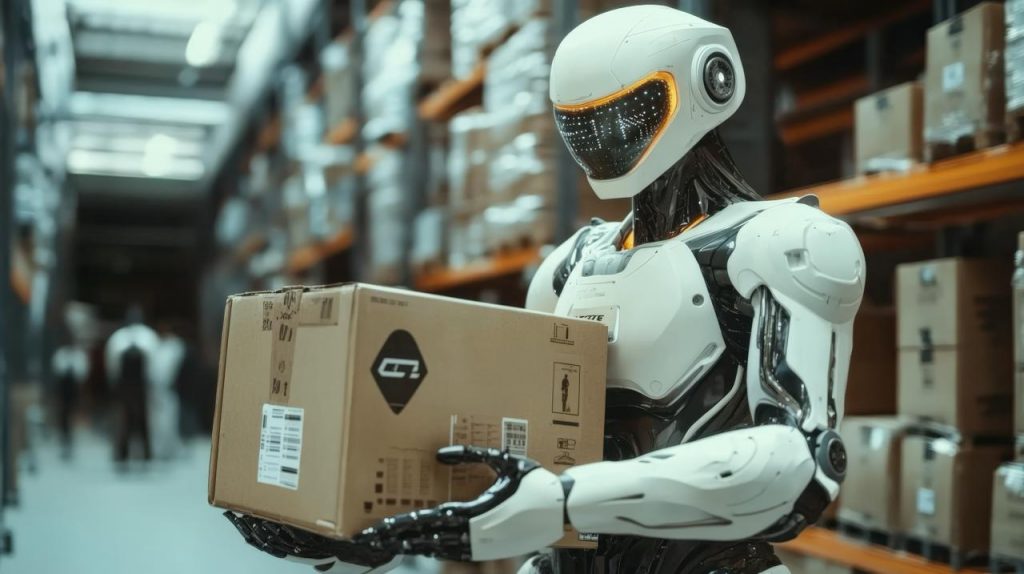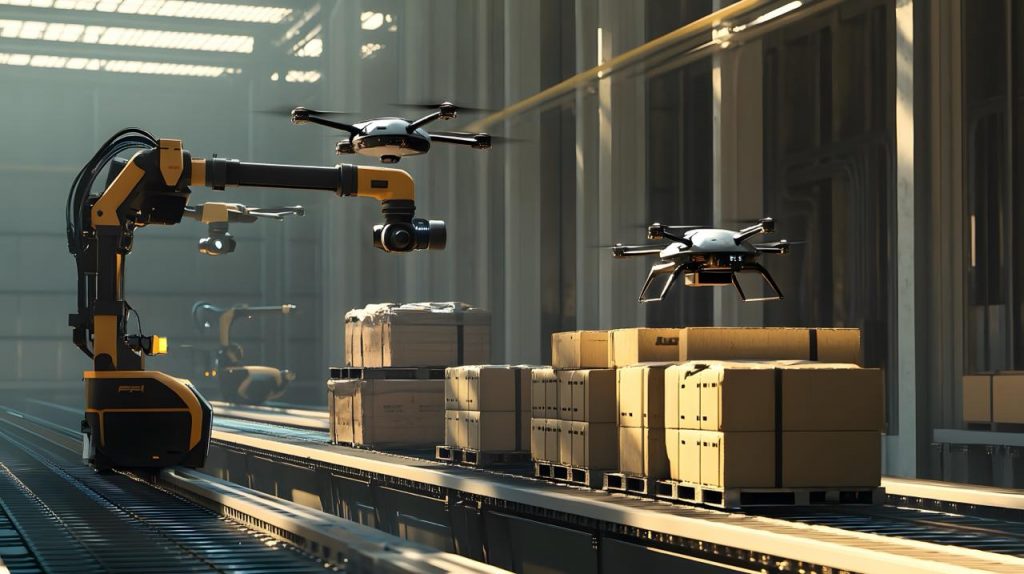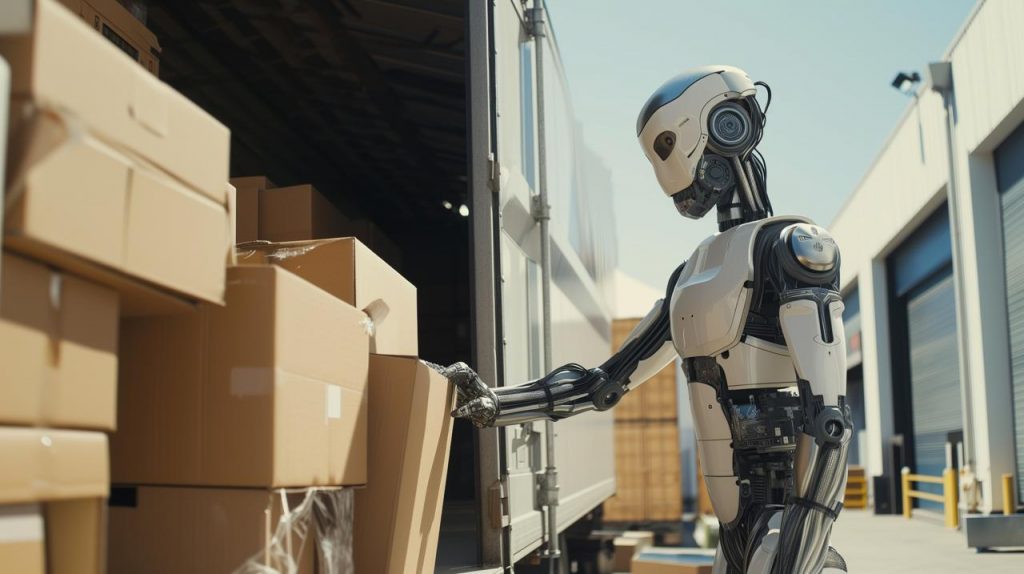Transportation runs on artificial intelligence now. This innovation happened in no time. Many systems that once required human oversight now operate automatically.
What used to take hours—route planning, for example—now takes minutes. Traffic lights adjust to real conditions. There’re no more fixed schedules. Fleet maintenance happens before breakdowns occur, which really improves logistics, public transit, and freight operations.
Companies that use AI see quick improvements: fuel costs drop, equipment lasts longer, customer satisfaction increases. Over time, these benefits grow as systems become smarter.
Current AI applications cover essential transportation functions. Route optimization reduces travel time and fuel use, while predictive maintenance prevents costly repairs. Fleet tracking provides complete operational visibility. Traffic management coordinates entire city networks.
The technology develops rapidly. It leads to lower costs, better capabilities, and seamless Integration between systems.
Transportation businesses must choose their path forward. Companies can adopt AI and gain competitive advantages, but those that wait fall behind industry standards. Artificial intelligence transformed transportation from a traditional industry into a technology-driven sector. This change defines how goods move and people travel today.
The Strategic Impact of AI on Modern Transportation & Logistics
Artificial intelligence is redefining what’s possible in transportation and logistics—turning data into decisions, and inefficiencies into innovation. At its core, AI in transportation management applies machine learning, real-time data processing, and automation to make operations more intelligent, agile, and scalable.
In logistics, AI powers predictive maintenance, route optimization, and demand forecasting—allowing companies to reduce fuel costs, cut delays, and allocate resources more effectively. Traffic jams and bad weather used to derail delivery schedules, but AI systems now watch conditions constantly and automatically reroute vehicles before problems hit. The result is fewer delays and deliveries that actually arrive on time.
Adoption is still in its early stages. While the AI in the transportation market is expected to grow rapidly—driven by the need for smarter supply chains and sustainability—many businesses lack a structured roadmap to implementation.
The role of AI in transportation isn’t just about automation. It’s more complex because it enables better planning, safer mobility, and more responsive service delivery. As AI applications in transportation expand—from autonomous vehicles to smart freight tracking—it’s becoming a critical tool for any company looking to stay competitive in an increasingly fast-moving world.

How AI Capabilities Have Progressed
The power of AI in transportation has grown from simple automation to advanced, real-time decision-making. Early systems helped with route planning. Today, they predict traffic jams, detect hazards instantly, and adjust signals to prevent delays before they happen.
AI in logistics and transportation now supports dynamic rerouting, allowing vehicles to avoid accidents or road closures on the fly. In urban areas, adaptive traffic signals powered by AI reduce congestion by analyzing real-time traffic volumes—not just preset timers.
Modern AI transport systems can also monitor driver behavior, recognize fatigue, and suggest breaks—improving safety and reducing accidents. In public transportation, AI predicts passenger demand, helping agencies deploy resources more effectively, even during unexpected spikes.
Behind the scenes, AI evaluates massive datasets from sensors, cameras, and GPS systems to guide smarter planning. This means fewer delays, optimized maintenance schedules, and more sustainable energy use.
AI in transportation applications continues to evolve—shifting from reactive tools to proactive systems that prevent problems before they impact the network. The more data these systems get, the more intelligent and responsive they become. It contributes to safer, and more efficient movement of people and goods.
AI-Driven Technologies Reshaping Transportation and Logistics
Understanding how AI is used in transportation means recognizing the technologies working behind the scenes. It’s not one single system—but an interconnected ecosystem of smart tools driving real-time decisions, optimizing movement, and reducing waste across the supply chain.
Machine Learning in Transportation and Logistics
Machine learning enables systems to analyze vast datasets, recognize patterns, and adapt without manual programming. In logistics, this translates into smarter inventory planning, predictive maintenance, and automated route optimization. Companies can react to real-time conditions while also forecasting future disruptions before they occur.
Big Data Analytics in Transportation
AI thrives on data. Big data tools gather insights from shipment records, GPS signals, customer behavior, and weather forecasts—turning raw input into accurate forecasts and actionable insights. This supports better decision-making in transportation planning and demand forecasting, while also minimizing delays and operational inefficiencies.
IoT in Shipping and Fleet Management
Sensors attached to trucks, cargo, and roads track everything that matters—where vehicles are, how hot packages get, whether fuel runs low. When AI processes this constant stream of data, it can instantly change routes, spot engine problems early, and show exactly where shipments are at any moment.
Computer Vision
Cameras became the eyes of transportation systems. They help self-driving cars spot pedestrians, monitor traffic flow at busy intersections, and scan package labels in warehouses. Basically, they teach machines to see and understand what’s happening around them.
Natural Language Processing
Voice commands now control vehicle systems. Customer service chatbots answer shipping questions instantly. Even paperwork gets generated automatically when freight changes hands. The technology lets people talk to transportation systems like they would talk to a person.
Deep Learning & Robotics
Deep learning enhances all of the above by making systems more accurate and intuitive. Robotics brings AI to life—automating warehouse sorting, managing last-mile delivery, or piloting autonomous vehicles with minimal human input.
These AI applications in transportation create a foundation for faster, safer, and more adaptive logistics systems.
Key Benefits of AI in Transportation and Logistics
Moving goods used to rely heavily on human judgment and experience. AI applications change that by making decisions based on data, cutting waste, and improving accuracy across entire operations. Here’s how transportation companies actually benefit from these technologies.
Route Optimization
Traffic shifts throughout the day. Weather disrupts planned routes. Road construction blocks familiar paths. AI systems track all these variables simultaneously and adjust routes automatically. The savings add up quickly—even cutting 15 minutes from each delivery route can save thousands of dollars monthly for larger fleets.
Predictive Fleet Maintenance
Instead of reacting to breakdowns, predictive maintenance powered by AI uses sensor data to forecast mechanical issues before they become costly failures. AI identifies patterns from historical data—mileage, wear trends, and engine diagnostics—to alert maintenance teams at the right time. This minimizes downtime and extends vehicle lifespan.
Cutting Operational Costs
Running a transportation business gets expensive quickly. Fuel prices fluctuate. Labor costs keep rising. Equipment breaks down at the worst times. AI helps companies tackle these problems systematically. Routes become more efficient, which burns less gas. Warehouses need fewer people to run smoothly. Trucks spend less time parked and more time moving cargo. The technology also spots mistakes before they turn into major headaches.
Better Space Usage
Wasted cargo space costs real money. A half-empty truck still uses the same amount of fuel as a full one. AI solves this puzzle by figuring out how to pack shipments more intelligently. It looks at box sizes, weight limits, and where everything needs to go. More stuff fits in each trip. Companies make fewer runs to deliver the same amount of cargo. That means lower fuel bills and happier customers.
Vehicle Tracking
AI in logistics and transportation relies on IoT sensors for real-time vehicle tracking. Sensors on trucks send live updates to dispatch. Managers always know where vehicles are, how they’re running, and if something needs attention. Drivers can’t make unscheduled detours without it being noticed. Customers get delivery times they can trust. If an issue comes up, it’s flagged right away instead of hours later.
Inventory Management
Stock control is very important. Too much stock meant wasted money. Too little meant unhappy customers. Modern systems now track sales patterns and forecast demand. They recommend when to reorder and how much to keep in storage. That prevents both empty shelves and warehouses filled with slow-moving goods.
Workforce Management
AI supports HR teams by automating repetitive tasks. Scheduling drivers and warehouse crews is a tedious task. Software can take care of it by assigning shifts, tracking training, and monitoring performance. Over time, it also shows which workers are best suited for certain jobs. Managers can then focus on solving problems instead of drowning in paperwork.
Environmental Benefits
Efficient routing cuts fuel use. Better loading reduces the number of trips needed. Electric fleets can be managed with optimized charging schedules. These changes lower costs, help meet environmental rules, and reduce the company’s carbon footprint.
Safety Improvements
Many accidents may happen when drivers are tired or visibility is poor. Monitoring systems can detect fatigue or risky driving behavior early. Traffic signals can even adjust to reduce the chance of collisions. Since human error is behind most accidents, reducing those risks makes roads safer for everyone.

Challenges and Limitations of AI in Transportation and Logistics
On paper, the technology looks flawless but there is alwys but. Companies roll out new systems expecting smooth operations, only to run into delays, high costs, or features that don’t work the way they were promised. The lesson: know the risks before committing big budgets.
Privacy and Security Risks
Modern logistics tools collect a lot of sensitive information — driver locations, delivery routes, customer addresses, payment details. Without robust cybersecurity measures, this creates vulnerabilities. If that data leaks, the fallout is serious. It can lead to lawsuits, fines, and angry customers.
Initial Investment Requirements
One of the biggest problems of using AI is the price. Implementing AI in transport requires buying specialized software and hardware, upgrading infrastructure, and training staff. Small and mid-sized companies may struggle to justify or afford this upfront investment—especially when the ROI is not immediate. Ongoing costs for system maintenance, updates, and data storage can also add up over time.
Infrastructure Limitations
AI solutions often rely on strong digital infrastructure—such as IoT networks, high-speed internet, and 5G coverage. AI needs solid internet connections and modern networks to function properly. Try running sophisticated routing software in rural Montana where cell service cuts out every few miles. Many regions still lack the basic digital infrastructure these systems require. Companies discover their expensive AI investment works great in major cities but fails completely in smaller markets where they also need to operate.
Integration Headaches
Dropping AI into existing transportation systems rarely works smoothly. Old software doesn’t talk to new AI programs. Different departments use incompatible systems. What should be a simple upgrade turns into months of custom programming and system rebuilding. IT teams pull their hair out trying to make everything work together. Budgets explode beyond original estimates.
Job Displacement Issues
AI eliminates certain jobs—that’s just reality. Dispatchers, route planners, and warehouse coordinators watch computers take over tasks they’ve done for years. Some workers adapt and learn new skills. Others get pushed out. Companies that ignore this problem face angry employees, bad publicity, and high turnover. Smart businesses retrain their people instead of just replacing them.
Algorithm Bias Problems
AI learns from historical data, which often contains hidden prejudices. Maybe past routing decisions avoided certain neighborhoods for questionable reasons. The AI picks up these patterns and perpetuates them. Customers in affected areas get worse service without understanding why. Companies face discrimination lawsuits they never saw coming.
AI transforms transportation, but only when companies plan carefully and avoid these common traps.
How Is AI Used in Transportation? Real-World Applications & Expert Insights
Artificial Intelligence (AI) is redefining transportation across every mode—road, air, rail, and even autonomous drones. From predictive maintenance to eco-friendly route planning, AI in transportation isn’t a buzzword—it’s a reality that’s already improving safety, speed, and sustainability. Below, you can find out how AI is used in transportation and logistics, including expert-level explanations and real-world examples for each major application.
1. Predictive Maintenance
AI uses data from sensors installed in vehicles in order to predict potential mechanical failures before they happen. These systems monitor engine temperature, vibrations, oil levels, and other indicators to determine when a part may need servicing.
Example: Logistics fleets use AI-powered dashboards to schedule repairs before vehicles break down, avoiding expensive delays. In aviation, Airbus uses Skywise, an AI platform, to analyze flight data and predict maintenance needs—improving safety and reducing costs.
2. Better Traffic Management
In the past, traffic lights ran on timers and rough estimates. Today road networks are monitored with cameras, sensors, and GPS data. When congestion builds, the system adjusts light timing and directs drivers to alternate routes in real time.
Pittsburgh showed how effective this can be. After installing a smart traffic system, average drive times dropped by about 25%, and emissions fell by 20%. Because it learns from years of traffic flow, the system reacts to sudden jams far better than fixed schedules ever did.
3. Improved Road Safety
AI minimizes human error—responsible for over 90% of accidents—by integrating advanced driver assistance systems (ADAS). These systems detect unsafe driving behavior and automatically engage braking, lane correction, or alerts.
Example: AI-powered dashcams in commercial fleets detect driver distraction or fatigue, sending real-time alerts to prevent crashes.
4. Self-Driving Vehicles
Cars that drive themselves used to be pure science fiction. Now they’re cruising around Phoenix and San Francisco. These vehicles use multiple sensors—cameras, radar, laser scanners—to see everything around them. AI processes all that information instantly to make driving decisions.
Waymo runs actual taxi services with no human drivers. Tesla owners let their cars handle highway driving. Trucking companies test autonomous semis on long desert routes where there’s less traffic to worry about. The technology still has hiccups, but it’s getting better fast.
5. Smarter Public Transit
Bus and train systems now adjust to how people actually travel instead of sticking to rigid schedules. AI tracks ridership patterns and suggests changes—more buses during rush hour, fewer during slow periods.
London’s subway system uses this approach to set ticket prices and improve routes. Some cities run buses that change their paths based on where people need to go that day. No more empty buses running the same route regardless of demand.
6. Cleaner Transportation
AI helps vehicles burn less fuel and produce fewer emissions. It optimizes engine performance, reduces time spent idling, and helps electric vehicle fleets manage their charging schedules. The environmental benefits add up quickly across thousands of vehicles.
Example: Walmart saved 94 million pounds of CO₂ by using AI to eliminate 30 million unnecessary miles through route optimization. EV fleets now use AI to plan efficient charging and usage schedules.
7. Route Optimization for Logistics
AI can calculate the fastest, safest, and most cost-efficient delivery routes by analyzing traffic, weather, road closures, and fuel costs.
For perishable goods, this means faster delivery and reduced spoilage.
8. Driver Behavior Analytics
AI tools evaluate driving habits using telematics data—speed, braking, acceleration—to identify risky behaviors.
Example: Fleet managers receive behavior scores and real-time alerts when drivers exceed safe thresholds. This leads to safer roads, lower insurance premiums, and reduced vehicle wear.
9. Better Vehicle Tracking
Knowing where your delivery truck sits doesn’t tell the whole story. Is the driver stuck in traffic? Did weather slow them down? Is the cargo urgent enough to justify sending backup? AI pieces together all these details and makes suggestions. Instead of calling customers with vague “your package is delayed” messages, companies can explain exactly what happened and when things will get back on track.
10. Personalized Travel
Your phone learns how you like to travel. Prefer quiet Uber rides? It matches you with drivers who don’t chat. Take the same train every morning? The app warns you about delays before you leave home. Technology finally catches up to how people actually want to travel instead of forcing everyone into the same box.
11. Smarter Fleet Decisions
Fleet managers used to spend their days playing vehicle Tetris—matching trucks to routes, scheduling maintenance, figuring out fuel stops. AI handles most of these decisions now. It knows which trucks work best for fragile cargo, which drivers perform better on long hauls, and when vehicles need service before they break down. Managers can focus on bigger challenges instead of daily scheduling headaches.
12. Parking That Actually Works
Circling the block looking for parking spots drives everyone crazy. Smart parking systems spot empty spaces and send the location to your phone. Some cities let you pay through apps. Others adjust prices so popular areas cost more during busy times. San Francisco residents can actually find parking downtown now—something that seemed impossible just a few years ago.
13. Environmental Impact Reduction
AI enables greener transportation by identifying low-emission routes, promoting EVs, and maximizing load utilization.
Example: Logistics firms use AI to avoid “empty miles”—when trucks return without cargo—by matching return loads with available capacity, cutting emissions.
14. Drone Taxis and Driverless Buses
AI powers the control systems behind flying taxis and autonomous mass transit.
Example: Dubai has tested drone taxis using AI for autonomous flight control and route navigation. In Helsinki, driverless electric buses operate on fixed routes, using AI to adjust speed and avoid collisions.
15. License Plate Recognition
AI systems read and interpret license plates for tolling, access control, and law enforcement.
Example: Highway systems in the U.S. and Europe use license plate recognition for automatic toll collection, reducing congestion at toll booths.
16. Vehicle Health Monitoring
Delivery trucks collect information constantly while driving. How hard the engine works going uphill. Whether the brakes grab properly. How much diesel disappears on different routes. Fleet managers used to wait for breakdowns to learn about problems. Now they get warnings weeks ahead of time. That one truck that always seems to need more fuel? Turns out the air filter needs replacing. Small fixes prevent big headaches.
17. Railway Maintenance That Prevents Disasters
Train wheels hit tracks thousands of times per trip. Metal fatigue builds up gradually. Deutsche Bahn figured out how to listen for trouble—sensors detect tiny vibrations that signal wheel problems developing. What used to cause sudden breakdowns now gets caught early. Maintenance crews replace parts during scheduled downtime instead of dealing with emergency repairs that strand passengers.
18. Accurate Flight Arrival Times
Flight delays used to be mysterious. Pilots would announce “a little weather ahead” then sit on the tarmac for hours. AI systems now track storms, airport congestion, even how long it takes specific aircraft types to taxi. When your app says the plane lands at 3:47 PM instead of 3:30 PM, that seven-minute difference reflects real conditions. Ground crews prepare accordingly instead of scrambling when flights arrive unexpectedly.
19. Smarter Train Operations
City events mess with train schedules. Concert lets out and everyone wants to go home simultaneously. Big game brings thousands of visitors who don’t know the subway system. Railway operators used to add extra trains based on hunches. AI tracks ticket purchases, event attendance, even social media buzz to predict passenger surges. The right number of trains run at the right times.
20. Pedestrian Detection
AI-powered cameras detect pedestrians and anticipate movement to avoid accidents—critical for AVs and smart city infrastructure.
Example: ADAS systems in modern vehicles use pedestrian recognition to apply emergency braking when a person unexpectedly crosses the road.
21. Traffic Lights That Pay Attention
Traffic lights used to follow the same timing all day, every day. School gets out at 3 PM and kids flood the crosswalks? Too bad—the light still changes every 90 seconds like clockwork. Smart traffic systems actually watch what happens and respond. More pedestrians crossing means longer walk signals. Stadium events trigger adjusted timing to handle the crowd surge. The lights work with real conditions instead of ignoring them.
22. Finding Road Problems Before They Get Worse
Potholes start small, then swallow car tires whole. Cities used to rely on citizen complaints to find road damage. Now cameras mounted on maintenance trucks scan streets automatically. AI spots cracks, worn paint, and surface problems while they’re still fixable. Repair crews get precise locations and photos of damage. Roads get fixed before they become hazardous instead of after someone’s car gets damaged.
23. Catching Traffic Problems Automatically
Highway cameras do more than just watch traffic now. AI analyzes video feeds to spot accidents, stalled vehicles, and dangerous driving in real time. A fender-bender on the interstate triggers automatic alerts to emergency responders. Someone runs a red light and the system flags it immediately. Traffic control centers learn about problems within minutes instead of waiting for phone calls from frustrated drivers.
24. Driver Monitoring
AI monitors driver alertness using in-cabin cameras and biometric sensors.
Example: Systems detect yawning, head drooping, or distracted glances and issue alerts or slow the vehicle. This is especially important in commercial transport to reduce fatigue-related crashes.

How to Adopt AI in Your Logistics Business
Most companies dive into AI without a clear plan, then wonder why their expensive technology doesn’t deliver results. Smart businesses take a different approach—they figure out exactly what problems need solving before buying any software.
Figure Out What You Actually Need
Skip the buzzwords and focus on real problems. Do trucks waste time sitting in traffic? Are customers constantly asking where their deliveries are? Does your warehouse run out of popular items while overstocking slow movers? Write down specific issues that cost money or frustrate customers. These become your AI targets, not vague goals like “being more innovative.” These insights will guide your choice of AI tools and ensure a measurable ROI.
Check If You’re Ready
AI needs good data and people who understand technology. Can your current systems handle constant information streams? Do you have staff who can interpret what AI tools tell them? Many companies discover their infrastructure can’t support the AI solutions they want. Better to upgrade systems first than install AI that doesn’t work properly.
Get Your Data House in Order
AI learns from historical information—shipping records, vehicle performance logs, customer patterns. Most companies have this data scattered across different systems in various formats. Clean it up and organize it before attempting any AI implementation. Garbage data produces garbage results, no matter how sophisticated the algorithms.
Start Small and Test Everything
You can pick one specific problem and test AI solutions in a controlled environment. Maybe route optimization for a single delivery zone. Monitor results carefully and adjust as needed. Expand gradually once you prove the technology works. Companies that try to transform everything at once usually fail spectacularly.
Concerns and Ethical Considerations in AI-Driven Transportation
AI promises to fix transportation problems, but it creates new ones that nobody talks about much. Companies rush to implement these systems without thinking through the consequences that affect real people’s lives.
When Algorithms Play Favorites
One major concern is bias in AI algorithms. AI learns from past decisions, including bad ones. If ride-sharing companies historically avoided certain neighborhoods, the AI picks up that pattern and continues it. Some areas get flooded with available cars while others get ignored. The technology makes discrimination more efficient, not less biased. People in affected communities notice the difference immediately.
Your Data Goes Everywhere
Transportation AI knows where you go, when you travel, who you meet. Your car tracks conversations. Transit apps record daily routines. Ride-sharing services build detailed profiles of passenger behavior. Most people have no idea how much personal information these systems collect or where it ends up. Data breaches expose intimate details about millions of travelers.
Hackers Love Connected Cars
Every smart vehicle becomes a potential target. Criminals could take control of steering, disable brakes, or manipulate traffic systems. A successful attack on transportation infrastructure affects entire cities. Companies spend billions on cybersecurity, but hackers only need to find one weakness to cause chaos.
Millions of Jobs Disappear
Truck drivers, taxi operators, delivery workers—AI eliminates these jobs faster than new ones get created. Entire communities built around transportation work face economic collapse. Retraining programs sound good in theory but often fail to help displaced workers find equivalent employment. The technology benefits companies while destroying livelihoods.
Hidden Environmental Costs
Training AI systems burns enormous amounts of electricity. Building smart infrastructure requires rare metals mined in environmentally destructive ways. The technology that’s supposed to help the planet consumes massive resources during development. Companies advertise the green benefits while hiding the environmental costs of creating AI systems.
These problems won’t solve themselves. Someone needs to make hard decisions about how AI gets developed and deployed in transportation.
Future Trends in AI and Smart Transportation
Transportation technology changes so fast now that what seems impossible today becomes routine within a few years. The transformation ahead will completely reshape how people and goods move around.
Self-driving cars represent just the tip of the iceberg. Companies already test autonomous trucks on long highway routes between major cities while delivery robots navigate suburban sidewalks. The technology still has rough edges, but improvement happens rapidly. Human drivers might become the exception rather than the rule within a decade. When parking lots become unnecessary and traffic flows more predictably, entire cities will need to rethink their design.
Traffic jams pushed innovation skyward. Electric aircraft that take off vertically—quieter than helicopters—are moving from science fiction prototypes to actual commercial services. These air taxis won’t replace ground transportation completely, but they’ll handle short trips across congested urban areas. Flying from downtown to the airport in ten minutes instead of sitting in traffic for an hour could become normal.
Roads, bridges, and traffic systems are evolving into intelligent networks that communicate constantly. Singapore and Amsterdam demonstrate how AI manages traffic flow in real time. Public buses and trains modify their routes dynamically based on where passengers actually want to go. The entire transportation grid learns and adapts continuously.
Package delivery is transforming through automation. Drones, robots, and autonomous vehicles might handle most deliveries within the next few years while warehouses operate with minimal human supervision. Last-mile delivery becomes faster and cheaper through systems that work around the clock without breaks or overtime pay.
These developments aren’t distant possibilities—they’re happening right now in test programs scattered across the globe, quietly preparing to change how everyone travels and receives goods.
Frequently Asked Questions (FAQs) about AI in Transportation
Ever notice how some traffic lights seem to “know” you’re coming? That’s AI watching traffic patterns through cameras and sensors scattered around the city. When an accident blocks traffic on Main Street, the system automatically adjusts lights on side streets to help cars flow around the problem. Pittsburgh tried this approach and cut commute times by 25%.
Your car already tells you when it needs an oil change. AI takes this concept much further by listening to how engines sound, watching brake performance, and monitoring tire wear patterns. Instead of following rigid maintenance schedules, the system warns you about problems developing weeks before they cause breakdowns. Cities use similar technology to spot potholes forming, bridge stress developing, or railway tracks wearing unevenly. Fix small problems early and avoid big expensive disasters later.
Fleet managers used to spend half their day on the phone asking drivers where they were and why deliveries were running late. Now AI systems track everything automatically—vehicle locations, traffic delays, fuel consumption, even whether drivers are taking efficient routes. When problems happen, managers know immediately instead of finding out hours later. The technology spots patterns too, like which trucks consistently use more fuel or which routes always run behind schedule.
Your phone remembers how you like to travel. Always book window seats? The app learns that. Take the same train every morning? It warns you about delays before you leave home. Need a ride to the airport? The system suggests departure times based on your flight and current traffic. Instead of generic service, transportation apps adapt to individual habits and preferences, making travel feel more personal and predictable.
Self-driving cars process information faster than human brains can handle. Cameras spot pedestrians, radar detects other vehicles, sensors feel road conditions—all feeding into AI systems that make split-second decisions about steering, braking, and acceleration. The technology learns from millions of driving situations, getting better at handling everything from parking lots to highway merges.
Conclusion
Transportation runs on AI now. AI can plan routes in seconds instead of hours. Vehicles can predict maintenance needs before breakdowns occur. Traffic lights adapt to real conditions. Passengers get personalized experiences that actually work.
This technology is not the future any anymore. It is essential for staying competitive. Companies using AI see lower costs and smoother operations. Those that don’t fall behind as competitors pull ahead with smarter systems.
Implementation isn’t simple though. Data security matters. Existing equipment often conflicts with new AI tools. Let’s bring your transportation business into the future—smarter, faster, and more resilient.




